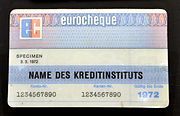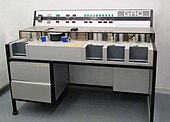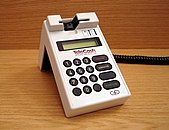Siegfried Otto
Siegfried Otto (born December 25, 1914 in Halle (Saale) ; † August 17, 1997 in Munich ) was a German entrepreneur . From 1948 he rebuilt the company Giesecke & Devrient (G&D) in Munich and developed it into an international market leader for security solutions for printing banknotes and securities , the production of security paper, banknote processing systems for central banks , systems for payment transactions and chip cards .
Life
The son of police chief Erich Otto and Emma Gumbrecht did an apprenticeship at the printing house Schaedel & Friebel in Leipzig . He then worked at the Giesecke & Devrient security printing company in Leipzig. Siegfried Otto was a captain in the German Wehrmacht during World War II . In March 1943 he married Jutta Devrient (December 29, 1921 - August 13, 2011), the daughter of Ludwig Devrient (October 28, 1894 - March 31, 1948), who ran the traditional company Giesecke & Devrient as chairman of the board until it was expropriated in 1948 led. Siegfried Otto was released from Soviet custody in Bautzen in March 1948 and moved to Munich to live with his wife.
Four children were born in his marriage to Jutta Otto-Devrient: Verena (* February 2, 1949), Claudia (* 1951), Tilmann (* 1953) and Yorck (* 1956). After divorcing Jutta, he married Ursula Burda (née Gamstätter) for the second time in 1989.
Entrepreneurship
Reconstruction of Giesecke & Devrient
After the death of Ludwig Devrient and after the Leipzig company was converted into a state-owned company (VEB) in 1948, Siegfried Otto convened a general meeting of what was then G&D AG on June 3, 1948 in Munich. There it was decided to move the headquarters of Giesecke & Devrient AG to Munich. The entry in the commercial register took place on June 10, 1948. Otto then gradually expanded the Giesecke & Devrient company by founding various subsidiaries and acquisitions into an internationally operating group. In 1958 the first foreign subsidiary was founded in Mexico and the first print job for the German mark was carried out. Otto cooperated with the pioneers Gualtiero Giori, Albert Amon ( SICPA printing inks) and Koenig & Bauer as a machine manufacturer to improve the printing machines for steel printing . In 1964, the Louisenthal paper mill in Gmund am Tegernsee was purchased for the manufacture of security paper . From 1968 Otto played a key role in the development and introduction of the eurocheque system and the eurocheque card as a Europe-wide procedure for the guaranteed cashing of checks , together with Eckart van Hooven , member of the board of directors of Deutsche Bank and then chairman of the supervisory board of G&D.
Girocard from 2004 (manufactured by G&D)
Expansion of the product portfolio
In 1969 Siegfried Otto acquired all of the company shares in the BG Teubner Stuttgart publishing house and incorporated the publishing house into the group of companies. In 1970 the Society for Automation and Organization (GAO) was founded as a research and development company, with Helmut Gröttrup as the first managing director. This start-up company established new business fields with banknote processing systems for central banks , security features for banknotes for automatic authentication, systems for processing payment transactions such as the payment terminal ZVT 700 and the banknote identification module BIM 1000, as well as chip cards and their personalization using laser technology .
Takeover of the Leipzig headquarters
After German reunification, Otto bought back the headquarters of the printing company in Leipzig in 1991 and acquired the Königstein paper mill near Dresden. With this capacity expansion, he took a decisive step for the subsequent position of Giesecke & Devrient (renamed Giesecke + Devrient in 2018 ) as the world's leading provider of complete solutions for all aspects of banknotes. He was chairman of the management of Giesecke & Devrient until 1994. After that he was a member of the supervisory board for two years.
After his death on August 17, 1997, his daughters Verena von Mitschke-Collande and Claudia Miller inherited the company in equal parts and maintained the separation between capital and management that had existed since 1994.
In the company's internal obituary, Siegfried Otto was described as follows:
“He not only had entrepreneurial qualities such as the consistent will to succeed, a visionary instinct with a healthy sense of reality and a never-ending dynamic. His human qualities were also exceptional. [...] He always saw the person in the employee. For him, leadership meant being an example. His top priority was: work a little more than others! A little faster and a little harder! Always try to be better than others. "
Tax offense
In 1993 Siegfried Otto filed a voluntary disclosure with the tax office for a tax offense. He then paid more than DM 100 million in taxes from his private assets.
honors and awards
Siegfried Otto received a number of awards:
- 1974: Order of the Aztec Eagle (Mexico)
- June 21, 1976: Bavarian Order of Merit
- 1990: Federal Cross of Merit, 1st class
In October 2011 the International Association of Currency Affairs (IACA) accepted him into the Currency Hall of Fame with the following dedication :
“Siegfried Otto was an extraordinary businessman and a far-sighted thinker with a strong will to succeed. For over 50 years he worked tirelessly to achieve his goals. [...] His ideas and decisions had a decisive influence on the development of modern payment systems. [...] One of his most important acts was the implementation of his long-cherished vision of machine-readable banknotes, [...] the development of machines with the ability to authenticate banknotes, checks and other means of payment at high speed and with outstanding reliability. "
literature
- Heinrich Krämer, Jürgen Weiß: Siegfried Otto (1914–1997): Principal of Giesecke & Devrient and BG Teubner . Edition at Gutenbergplatz, Leipzig 2014, ISBN 978-3-937219-75-2 (43 pages).
- Jan Hendrik Prell; Horst Böttge: Giesecke & Devrient 1852–2002. Values through the ages . Ed .: Giesecke & Devrient. Deutscher Sparkassen Verlag, Stuttgart 2002, ISBN 978-3-09-303892-1 (260 pages).
- Astrid Wolff: Siegfried Otto 1914–1997. A life in pictures . Ed .: Giesecke & Devrient. Munich 2014 (80 pages).
- June 1, 1852 - The Giesecke & Devrient company is founded. Westdeutscher Rundfunk, June 1, 2012, accessed June 24, 2019 .
Individual evidence
- ^ Giesecke + Devrient (eds.): Siegfried Otto. A life in pictures . Munich 2014 (80 pages).
- ↑ Jutta Otto-Devrient on stiftung-teubner-leipzig.de
- ↑ a b c d e Jan Hendrik Prell; Horst Böttge: Giesecke & Devrient 1852–2002. Values through the ages . Ed .: Giesecke & Devrient. Deutscher Sparkassen Verlag, Stuttgart 2002, ISBN 978-3-09-303892-1 (260 pages).
- ↑ Felix Berg, Boris Fuchs: The “magic” triangle: machine - color - paper. VDD / IDD seminar "Stamp printing from the roll". 2005, accessed June 24, 2019 .
- ↑ Klaus W. Bender : Geldmacher: The most secret trade in the world . Wiley-VCH, 2004, ISBN 978-3-527-50113-7 (305 pages).
- ↑ 50 years of eurocheque: The story of a great European. CoinsWeekly, May 9, 2019, accessed on June 24, 2019 .
- ^ Siegfried Otto: Real or False? The machine authentication. The MM key of the cross-institute ATM system of the German credit associations . In: Zeitschrift Finanzinstitute . No. 6 , 1981, pp. 9-18 .
- ↑ Women, Money and Risk. (PDF; 179 kB) Der Spiegel, December 4, 1995, accessed on June 24, 2019 .
- ^ Siegfried Otto. Owner and chairman of the management board (CEO) Giesecke & Devrient GmbH. In: Currency Hall of Fame. International Association of Currency Affairs (IACA), accessed June 24, 2019 .
Web links
- Literature by and about Siegfried Otto in the catalog of the German National Library
- Biography Siegfried Otto on deutsche-biographie.de
| personal data | |
|---|---|
| SURNAME | Otto, Siegfried |
| BRIEF DESCRIPTION | German entrepreneur |
| DATE OF BIRTH | December 25, 1914 |
| PLACE OF BIRTH | Halle (Saale) |
| DATE OF DEATH | 17th August 1997 |
| Place of death | Munich |








